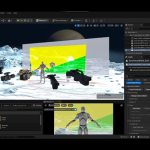Sony Alpha 7 IV comes with hybrid autofocus with improved speed, and AI-based real-time eye autofocus.
Sony has launched the Alpha 7 IV interchangeable-lens camera. It comes with a new 33-megapixel full-frame back-illuminated CMOS image sensor, wide ISO sensitivity range expandable to ISO 50-204,800, wide 15-stop dynamic range, latest BIONZ XR image processing engine, and two new flashes — the HVL-F60RM2 and HVL-F46RM.
The Sony Alpha 7 IV has 10 presets including S-Cinetone, S-Log3, and Creative Look for different creative outcomes. The Sony camera claims to offer up to 2.5x slow motion with 4K 60p movies. It integrates a 10-bit 4:2:2 All-I XAVC S-I for smoother gradations.
The Sony Alpha IV comes with hybrid autofocus with improved speed, AI-based real-time eye autofocus, and real-time tracking for photos and videos. It offers continuous shooting at up to 10fps with AF tracking and tracks subjects with 759 phase-detection AF points in a high-density focal-plane AF system that covers approximately 94% of the image area. The Alpha 7 IV is also said to come with face and eye detection accuracy for humans that is improved compared to the Alpha 7 III.
It comes with a 3.68m dot electronic viewfinder (EVF) with a 120 Hz refresh rate, up from the 2.36m dot, 60Hz EVF on the A7 III. For videographers, the A7 IV offers a flip-out 1.03m dot rear LCD display, making the camera far more usable for vlogging than the A7 III.
The 5-axis in-body stabilization delivers 5.5 stops of shake reduction, up slightly from before, but far below the 8 stops promised by Canon’s like-priced EOS R6.
In terms of storage, the A7 IV offers two slots, with the top dual-slot taking either SDXC UHS II (up to 300 MB/s speeds or CFexpress Type A (up to 800 MB/s), and the bottom slot compatible with SDXC UHS II only. On the A1 and A7S III, by comparison, both slots support both those formats. As for battery life, the A7 IV delivers 610 CIPA shots on a charge, compared to 700 on the A7 III.
As for the video, the A7 IV can shoot up to 4K 60fps though only with the APS-C portion of the sensor. This means a pretty serious crop. If you want to shoot with the full width of its sensor, you are limited to 4K 30fps. Videos can be captured in 10-bit 4:2:2 and for up to an hour before it needs to cool down.
The Sony Alpha 7 IV is integrated with a 33-megapixel back-illuminated CMOS image sensor and BIONZ XR image processor for up to 8x processing speed. It is also said to achieve a wide ISO sensitivity range expandable to ISO 50 – 204,800 and has a 15-stop dynamic range.
There’s a vari-angle LCD touch monitor on the Sony Alpha 7 IV for flexible positioning. It has an OLED quad-VGA viewfinder that is 1.6 times the resolution of the Alpha 7 III viewfinder. There are over 10 presets and 8 parameters to choose from. Presets include S-Cinetone, S-Log3, and Creative Look, Creative Look IN, and Creative Look BW. The camera has a dial for quick access to still, movie, and S&Q modes. The rear dial is also customisable and the camera offers new, mode-specific menus in the interface.
As mentioned, the Sony Alpha 7 IV claims to offer up to 2.5x slow motion with 4K 60p movies and integrates a 10-bit 4:2:2 All-I XAVC S-I for smoother gradations. Connectivity options include in-body wireless LAN (2.4GHz and 5GHz bands), Bluetooth, and a USB 3.2 Gen 2 Type-C port. It also offers real-time live streaming via USB connection including high-resolution 4K video.
The HVL-F60RM2 with GN 60 and 20-200mm coverage and HVL-F46RM with GN 46 and 24-105mm are wireless flashes to offer precise control, enhanced high-speed and intuitive operability. They are designed to meet the needs of both professional and advanced content creators when shooting with a Sony Alpha camera, including the Alpha 7 IV, to offer the ultimate Alpha Lighting System by the detailed communication between cameras and external flash.
Both flashes have upgraded continuous shooting flash performance, up to 200 consecutive flashes at 10 frames per second for the HVL-F60RM2 and 60 times for the HVL-F46RM. The optimised flash algorithm ensures both flashes are overheat-resistant, and a set of four Ni-MH (Nickel-metal hydride) batteries can power up to 240 flashes with a 1.7 second recycle time for the HVL-F60RM2 and up to 320 flashes with a 2.0 second recycle time for the HVL-F46R.
With the Alpha 1, the HVL-F60RM2 achieves up to 20fps of continuous shooting and approximately 20 flashes per second can be produced for more than 10 seconds with the external flash battery adapter FA-EBA1 (sold separately). When the Alpha 1 is used with Sony’s flashes, including HVL-F60RM2 and HVL-F46RM, users can sync up to 1/400 second shutter speed to expand expressive capabilities when shooting in full-frame mode. In addition, with the silent electronic shutter of the camera, silent flash shooting is possible when absolute silence is required.
Murat Gebeceli, Head of Digital Imaging, Sony Middle East & Africa, said: With the introduction of the Alpha 7 III, we set the baseline for what full-frame cameras should deliver and now it is time to redefine those boundaries. The Alpha 7 IV brings together the best of Sony imaging technology to deliver a fantastic experience in both stills and video, meaning that users in the Middle East & Africa region will be able to capture exactly the content that they want, in whatever situation they find themselves in.”
The camera is also compatible with the Camera Remote Software Development Kit (SDK).
The Alpha 7 IV will be available from November 2021 in the Middle East & Africa. The HVL-F60RM2flash and HVL-F46RMflash will be available from October 2021.


















































































